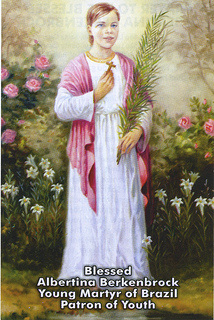
At an early age she learned to pray with deep devotion and was strong in the practice of her Catholic faith. She spoke of her First Communion Day as the most beautiful day of her life and had special devotion to Our Lady and to St Aloysius Gonzaga, a model of purity and the Patron Saint of São Luís.
At school Albertina was a model for her peers and a cause of admiration to adults. Her teachers especially praised her spirituality and morals, superior to children of her age. She was a diligent student who knew her Catechism and kept God's Commandments.
At home, when her brothers teased and taunted her, as siblings do, she would not retaliate. With her Christian upbringing, even the childhood games she played reflected her deep religious sense. She played happily with the poorest children and shared her bread with them.
At home, she was especially loving to the children of an employee of her father; while unknown to her, that man would become her future assassin.
His name was Maneco Palhoça but he was also known as Indalício Cipriano Martins or as Manuel Martins da Silva. Albertina often gave food not only to his children but to him as well. Since Maneco was African and racism was still a grave social ill, the young girl's goodness was especially noteworthy.
One day when Albertina was searching for a runaway bullock she came across Maneco loading beans into his cart. When she asked him if he had seen the bullock he pointed in the wrong direction to entice her to a place where he could satisfy his lust without attracting attention.
Innocently, Albertina followed Maneco's directions and came to a wooded area. On hearing twigs cracking she turned, thinking it was the bullock, and found herself face to face with Maneco. She was petrified.
He informed her of his intentions but she firmly refused him. Albertina fought hard for her virtue. Even when he threw her to the ground, she did her best to cover herself. Furious at having been morally defeated by the young girl, Maneco grasped her by the hair and slit her throat with a knife.
Maneco tried to cover up his crime. He said he had discovered her body and accused a man called João Candinho of killing her, who protested his innocence in vain. But people became suspicious because when Maneco passed through the room where Albertina's body was laid out, witnesses said that every time he approached her body, blood would seep from the gash in her neck.
Two days later, the Prefect of Imaruí sent for João Candinho. The official took a crucifix and together with Candinho and others, went to Albertina's home. He placed the crucifix on her chest, ordered João Candinho to lay his hands on the crucifix and swear that he was innocent. It is said that at that very instant the wound in her neck stopped bleeding.
Maneco tried to flee but was arrested. He confessed to his crime as well as two other murders. He was tried, convicted and given a life sentence. In prison he admitted to his fellow prisoners that he murdered Albertina because she resisted his rape attempts.
This testimony from his own lips is fundamental for determining this as a true martyrdom. Albertina's reaction is unequivocal, since she preferred to die rather than to submit.
On the very day of Albertina's death, the young girl was popularly proclaimed a martyr because everyone who knew her could testify to her Christian upbringing, good behaviour, piety and charity.
Her reputation as a martyr was confirmed when the local midwife who had examined her body stated that the attempted rape was not a success.
Shortly thereafter, people began speaking of graces received through Albertina's intercession.
She was buried in the cemetery at São Luís, but due to the fame of her martyrdom and the favours obtained through her intercession, her body was later placed in the Church of São Luís.
Taken from the Vatican Website

 RSS Feed
RSS Feed
